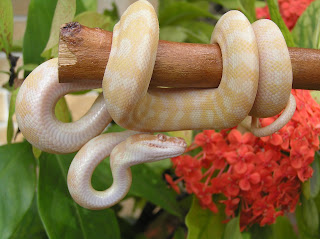The Western ratsnake (Pantherophis obsoletus) — also called black rat snake, pilot black snake, or simply black snake[2] — is a nonvenomous colubrid species found in North America. No subspecies are currently recognized.
Description
Adults can become quite large and are known to reach up to eight feet, being the largest snake found in Canada. The record length is 101 inches (2.6 m), making it (officially) the longest snake in North America. Unofficially, indigo snakes (Drymarchon couperi) are known to exceed them, and one wild caught pine snake (Pituophis melanoleucus) with a portion of its tail missing measured 111 inches (2.8 m).[citation needed]
Juveniles are strongly patterned with brown blotches on a gray background (like miniature fox snakes). Darkening occurs rapidly as they grow. Adults are glossy black above with white lips, chin, and throat. Sometimes traces of the "obsolete" juvenile pattern are still discernible in the skin between the scales, especially when stretched after a heavy meal.
Geographic range
The black rat snake is found throughout the Eastern and Central United States. In Canada it is found in lower Ontario. It is found in northeast United States, in particular New Jersey(northern), New York(eastern) and Vermont(southern).
Preferred habitat
It prefers heavily wooded areas and is known for having excellent climbing ability, including the ability to climb the trunk of large mature trees without the aid of branches. The black rat snake is a competent swimmer but usually (not always) uses this ability only to travel to additional hunting territory. During winter it hibernates in dens, often with copperheads and timber rattlesnakes. This association gave rise to the common name, pilot black snake, and the superstition that this nonvenomous species led the venomous ones to the den.
Behavior
When startled, they may freeze and wrinkle themselves into a series of kinks. If they feel further threatened, they may flee quickly or vibrate their tails in dead leaves (a form of mimicry, which makes them sound like rattlesnakes). They are also capable of producing a foul smelling musk which they will release onto a predator if picked up. They spread the musk with their tail in hopes of deterring the threat
Reproduction
Mating takes place in late May and early June. The male snake wraps its tail around the female with their vents nearly touching. The male then everts one of its sex organs, a hemipenis, into the female sex organ, cloaca. The mating lasts anywhere from a few minutes to a few hours. After five weeks the female lays about 12 to 20 eggs, which are 36–60 mm (1.4-2 in.) long by 20-26.5 mm (0.8-1.1 in.) wide. The eggs hatch about 65 to 70 days later in late August to early October.[9] The hatchlings are 28–41 cm (11-16 in.) in total length,[10] and they look like miniature fox snakes.
 |
| Elaphe obsoleta - A black rat snake (Elaphe obsoleta and Pantherophis obsoletus) |
Adults can become quite large and are known to reach up to eight feet, being the largest snake found in Canada. The record length is 101 inches (2.6 m), making it (officially) the longest snake in North America. Unofficially, indigo snakes (Drymarchon couperi) are known to exceed them, and one wild caught pine snake (Pituophis melanoleucus) with a portion of its tail missing measured 111 inches (2.8 m).[citation needed]
Juveniles are strongly patterned with brown blotches on a gray background (like miniature fox snakes). Darkening occurs rapidly as they grow. Adults are glossy black above with white lips, chin, and throat. Sometimes traces of the "obsolete" juvenile pattern are still discernible in the skin between the scales, especially when stretched after a heavy meal.
Geographic range
The black rat snake is found throughout the Eastern and Central United States. In Canada it is found in lower Ontario. It is found in northeast United States, in particular New Jersey(northern), New York(eastern) and Vermont(southern).
Preferred habitat
It prefers heavily wooded areas and is known for having excellent climbing ability, including the ability to climb the trunk of large mature trees without the aid of branches. The black rat snake is a competent swimmer but usually (not always) uses this ability only to travel to additional hunting territory. During winter it hibernates in dens, often with copperheads and timber rattlesnakes. This association gave rise to the common name, pilot black snake, and the superstition that this nonvenomous species led the venomous ones to the den.
Behavior
When startled, they may freeze and wrinkle themselves into a series of kinks. If they feel further threatened, they may flee quickly or vibrate their tails in dead leaves (a form of mimicry, which makes them sound like rattlesnakes). They are also capable of producing a foul smelling musk which they will release onto a predator if picked up. They spread the musk with their tail in hopes of deterring the threat
Reproduction
Mating takes place in late May and early June. The male snake wraps its tail around the female with their vents nearly touching. The male then everts one of its sex organs, a hemipenis, into the female sex organ, cloaca. The mating lasts anywhere from a few minutes to a few hours. After five weeks the female lays about 12 to 20 eggs, which are 36–60 mm (1.4-2 in.) long by 20-26.5 mm (0.8-1.1 in.) wide. The eggs hatch about 65 to 70 days later in late August to early October.[9] The hatchlings are 28–41 cm (11-16 in.) in total length,[10] and they look like miniature fox snakes.
 |
| Pantherophis obsoletus, Chatham County, North Carolina |






















































